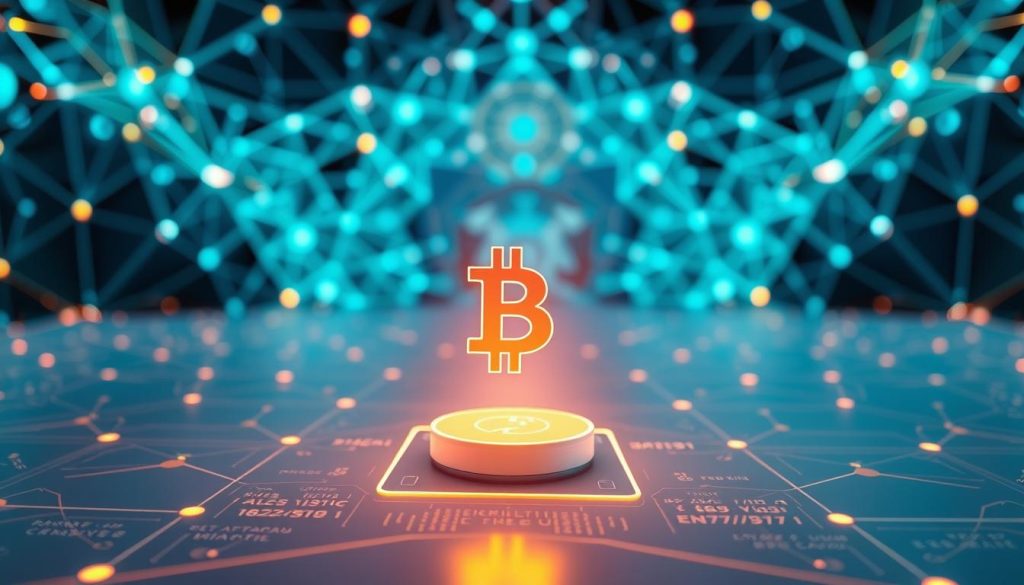The digital finance landscape is undergoing a seismic shift. Imagine a world where payments flow as effortlessly as emails, where machines negotiate transactions in real time, and where financial systems learn from market patterns. This isn’t science fiction—it’s the reality being built today.
At the heart of this transformation lies a groundbreaking innovation: the x402 protocol. Developed by Coinbase, this open-source framework reawakens the HTTP 402 status code—once a placeholder for payment systems—and turns it into a universal tool for instant value exchange. Erik Reppel, Coinbase’s engineering lead, compares it to HTTPS: “Just as secure connections defined the early web, x402 could power the next era of the internet.”
This protocol eliminates traditional banking delays by using digital currencies designed for automation. It’s chain-agnostic, settling transactions in seconds, making it ideal for everything from micro-payments to complex machine-to-machine interactions. The implications? Financial markets could soon operate with the same speed and intelligence as search engines.
Key Takeaways
- Coinbase’s x402 protocol transforms an unused web standard into a real-time payment layer
- Modern finance is shifting toward systems that automate transactions between devices
- New asset models enable instant global payments without traditional banking delays
- Financial ecosystems now integrate self-improving algorithms for smarter decisions
- These innovations create infrastructure for frictionless value exchange worldwide
Introduction: Shaping a Future of Automated Payments
The next wave of financial innovation is here. Traditional payment methods struggle to keep pace with machines that need to transact thousands of times daily. Built for human interaction, these systems crumble under demands for instant, tiny-value exchanges between devices.
Intelligent Capital’s Vision
Forward-thinking solutions now enable autonomous agents to handle micro-payments seamlessly. Imagine smart thermostats paying for energy usage by the second or delivery drones settling toll fees mid-flight. This requires infrastructure that operates at machine speed, not human banking hours.
Decentralized Finance Foundations
New frameworks remove middlemen from financial transactions. Peer-to-peer networks allow direct value transfers across borders. “We’re building rails for an economy where code handles money flows,” explains a fintech architect working on these systems.
| Traditional Systems | Automated Solutions |
|---|---|
| Manual approvals | Instant verification |
| Batch processing | Real-time settlements |
| High transaction fees | Fractional costs |
These changes empower users through self-managing financial tools. Programmable contracts automatically adjust to market shifts, creating smarter payment flows. The result? Financial ecosystems that work while you sleep.
The Evolution of HTTP 402 and the Rise of Machine Payments
Hidden in plain sight for decades, an unused web standard now fuels a financial revolution. The HTTP 402 status code—once a digital ghost town—has become the backbone of instant machine transactions.
From a Reserved Status to a Payment Enabler
Web creators designed the 402 payment required response in 1996. It aimed to let websites request payments through browsers. But global payment systems weren’t ready. For 25 years, this status code collected dust while others like 404 (Not Found) became household terms.
Today’s technology finally matches the original vision. Servers can now demand payment before granting access—just like the code’s designers imagined. A developer working on modern systems notes: “We’ve turned theoretical infrastructure into working plumbing for the web’s economy.”
| Common HTTP Codes | Purpose |
|---|---|
| 200 OK | Successful request |
| 404 Not Found | Missing resource |
| 402 Payment Required | Value exchange trigger |
Machine payments work differently than human transactions. Devices exchange value thousands of times daily—think sensors paying for data or apps buying API access. Traditional banking can’t handle this speed. The revived HTTP 402 creates a universal language for these micro-exchanges.
This shift transforms how we build online services. Websites no longer need complex billing systems. They can request payments as simply as showing a 404 error. The server handles the heavy lifting, making digital commerce as seamless as loading a webpage.
Integrating protocole X402, AI Agent, Blockchain, StableCoin
Modern applications demand payment systems that work like clockwork. The solution lies in combining web standards with advanced financial tools, creating seamless interactions between services and users.

How the Protocol Works in a Single HTTP Flow
This system turns payment processing into a natural part of web communication. Here’s the streamlined process:
- A client requests access to premium content or services
- The server responds with specific payment requirements
- Automated systems handle fund transfers behind the scenes
- Network confirmations happen in under three seconds
- Resources unlock instantly upon successful verification
Benefits for Developers, Agents, and Digital Services
Builders gain powerful tools without complexity. “You can monetize APIs like adding a contact form,” notes a tech lead at a major platform. Key advantages include:
Simplified integration: Existing apps require minimal code changes to enable transactions. Payment handling becomes part of standard web protocols.
Global reach: Services using dollar-pegged currencies avoid volatility issues while accessing worldwide markets. Settlement layers ensure fast confirmations across regions.
Automation-ready: Systems can negotiate micropayments without human oversight. This enables new business models where devices pay for resources as needed.
The open-source nature encourages innovation while maintaining compatibility. As adoption grows, expect more services to embrace this frictionless approach to value exchange.
Innovative Applications: AI, Micropayments, and Autonomous Transactions
Real-world implementations showcase the power of seamless, automated value exchange. Companies are redefining how digital services operate by charging fractions of a cent for resources. This shift enables unprecedented flexibility in pricing and resource allocation.

Real-World Use Cases and Industry Examples
Neynar’s social graph platform lets developers pay $0.001 per data query. Instead of monthly subscriptions, creators access identity information only when needed. “This turns APIs into vending machines for specialized data,” explains their chief architect.
Cal.com uses similar principles for scheduling tools. Their system charges users and software helpers per meeting booked. This approach eliminates flat fees, letting customers pay only for actual usage. Teams save up to 40% on collaboration tools through this model.
Emerging Opportunities in Machine-to-Machine Commerce
Hyperbolic’s compute marketplace demonstrates where this is heading. Software programs autonomously purchase GPU time, negotiating prices in real time. One neural network might rent processing power from another during peak demand.
These systems create self-managing economies. Devices trade resources like electricity or storage without human oversight. A delivery drone could buy weather data mid-flight, adjusting its route based on real-time transactions.
The future belongs to systems that transact as fluidly as they compute. From data streams to processing power, every digital resource becomes tradable at machine speed.
Navigating Challenges and Future Opportunities
Building tomorrow’s financial systems requires solving today’s toughest puzzles. While automated transactions promise efficiency, they introduce complex hurdles needing smart solutions.

Balancing Safety and Innovation
Security remains paramount in machine-driven finance. Software managing digital wallets must protect cryptographic keys like guarded treasures. “A single breach could disrupt entire payment networks,” warns a cybersecurity expert working on transaction infrastructure.
Regulators face new tests with anonymous value transfers. Traditional identity checks clash with blockchain’s privacy features. Major players adapt—Visa now offers cards linked to dollar-pegged tokens, while Stripe deploys advanced fraud detectors for instant transfers.
Three critical focus areas emerge:
- Multi-layered protection for wallet access
- Real-time compliance checks during transactions
- Adaptive systems that learn attack patterns
Payment giants like PayPal reward users adopting new methods, showing industry commitment to safe innovation. Their partnerships with crypto platforms hint at hybrid solutions blending speed with oversight.
The road ahead shines with potential. Developers craft self-auditing tools that verify transactions while maintaining speed. As infrastructure evolves, these advancements could make financial networks both smarter and safer—a win for businesses and consumers alike.
Conclusion
The way we exchange value online is undergoing a fundamental change. This evolution moves beyond simple transactions, creating systems where machines and software handle payments as naturally as loading a webpage. At the core lies a reimagined web standard that turns every digital interaction into a potential commerce opportunity.
Developers now wield tools that merge payment processing with standard web protocols. APIs can request funds as easily as fetching data, while autonomous services settle microtransactions in real time. This infrastructure empowers creators to build applications that seamlessly monetize resources, from compute power to content access.
As these models mature, they promise an internet where value flows as freely as information. The future of digital commerce isn’t about replacing humans—it’s about empowering systems to transact at the speed of innovation.
FAQ
How does the X402 protocol streamline digital transactions?
The X402 protocol simplifies payments by embedding stablecoin settlements directly into HTTP flows. Developers can integrate APIs to automate resource access, compute credits, or content delivery, triggering instant settlements like USDC transfers when a client receives data.
What benefits do autonomous agents bring to decentralized finance?
Autonomous agents enable frictionless machine-to-machine commerce. For example, IoT devices can negotiate micropayments for services in real-time using blockchain frameworks, reducing reliance on traditional payment gateways while boosting transaction speed.
How secure are transactions using stablecoins like USDC?
Stablecoins such as USDC operate on audited blockchain networks, ensuring transparency and compliance. Payments are cryptographically secured, and protocols like X402 add layers of verification, minimizing risks like fraud or chargebacks common in legacy systems.
Can the X402 framework work with existing web infrastructure?
Yes. The protocol leverages standard HTTP status codes, making it compatible with most APIs and web services. Developers can implement it without overhauling existing systems, using tools like Ethereum or Solana for tokenized settlements.
What industries benefit most from AI-driven payment models?
Sectors like streaming, SaaS, and IoT gain from automated micropayments. For instance, APIs could charge per API call or video stream, while smart appliances might pay for maintenance services autonomously—all powered by AI agents and decentralized ledgers.
How do regulatory frameworks impact decentralized payment systems?
Compliance varies by region, but protocols like X402 prioritize privacy and anti-money laundering standards. Partnering with regulated stablecoin issuers ensures transactions meet guidelines like GDPR or FATF travel rules, balancing innovation with legal safeguards.

Leave a Reply